#mind map examples
Explore tagged Tumblr posts
Text
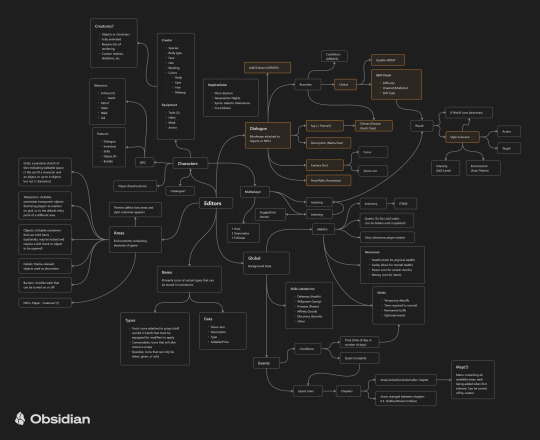
#inspired by:#spore galactic adventures#neverwinter nights#disco elysium#with some light wizard101/fire emblem?#game creator concept mindmap#ux example coming up soon; will reblog onto this#orange tiles are draggables onto dialogue sheet (mind map)
9 notes
·
View notes
Text
I've been thinking abt eternal gales which ofc means doing my thing where I imagine myself in a hypothetical interview and while going through the many scrapped elements of eternal gales in my head I remembered a huge chunk of the staliens stuff I scrapped and while I'm definitely not bringing it back I am lowkey rotating the idea of a soft prequel in my head. Nothing that I'll do anything with mostly just a thought exercise but still fun nonetheless
#rat rambles#oc posting#eternal gales#long story short in an older version of eternal gales the staliens were going to have their own equivalent to the au antags#the idea with them was that they were a group of staliens who had been brought here a long time ago and were basically left to meld with#the different parts of the universe core (which wasnt what it was at the time but thats what it ended up becoming later in development)#they weren't alternate versions of the stalien cast or anything they were completely different guys just to be clear#some of them actually ended up being recycled for some of the historical figures such as bettle and bugs for example#but yeah I scrapped the idea since the cast was already big enough and I knew there just wasnt space for them#with the updated worldbuilding tho this concept actually could have happened at some point in the far far past if I wanted it to#and I am a sucker for doomed narratives where the cast never had the chance to succeed because the story required they failed#plus it makes for a fun excuse to rotate more worldbuilding stuff around if I so desired#again I probably wont do anything with the idea for now but Ill keep it in my back pocket#maybe once the is@ eg au has fully faded from my mind Ill get enough worldbuilding withdrawal to do smth with it#speaking of worldbuilding I still need to get around to designing the planet map at some point#I dont technically need one but Id very much so like one#mainly because I need to figure out Where on the globe the main cast are located#I know their society is located in a very swampy area but idk where exactly thatd place them#I also need to officially decide the planet's position rotation all that jazz#well again I dont technically Need to but Id like to at some point#if only so I can decide wether or not the main cast gets notable seasons or not#I imagine they don't get particularly intense seasons but they might have smth going on idk#I generally try not to worry abt being 100% realistic with stalien worldbuilding but its still fun to think abt
0 notes
Text
For me at least hyperfixations and special interests like, can only be distinguished after a new one is gained. And there's something kinda tragic and wonderful about that. There will be something I love with my entire heart. That I think about constantly and yet I don't know if it's going to stay. Will I love it a decade from now? Or is it merely a fareweather friend until I find the next thing? Will I cringe a little at it's mention? Will I forget to some extent these characters and stories that I love over time? Will my merch be proudly displayed for the rest of my life or will I eventually condem it to a box of nostalgia? It doesn't mean it isn't special to me currently, that it holds no value or affection and hasn't helped me but I might loose it one day.
But there is a wonderful feeling when the next thing does come and the love stays. The enthusiasm stays. Maybe it isn't on my mind constantly but any mention of it lights up my day and brings me unending joy. It's with me forever now and that's such an incredible feeling
#autism#adhd#auadhd#is that the word?#anyway this is mostly about the later happening with ace attorney#im so fucking glad thats just here now forever#like ive had other special interests in this cycle but thats the one at the front of my mind right now#and when i compare it to other ones. like voltron or BNHA in my case as easy examples#when the next thing came along i couldn't even remember the plot of those#but AA im still like able to instantly tell you where an obsure line of dialogue happened and find the exact quote in under like 5 minutes#also this is not a quality thing plenty of my special interests are deeply flawed but the love persisits#the thing that kills me as well is how this maps onto like real relationships too a bit
1 note
·
View note
Text
i think its incredibly funny how any and every conspiracy theory falls apart when presented with like, two real world facts
#.din#.txt#the example that comes to mind is tierra australis on old maps#1. australia means southerly 2. people in oldentimes thought the world needed continental balance + were stupid
1 note
·
View note
Text
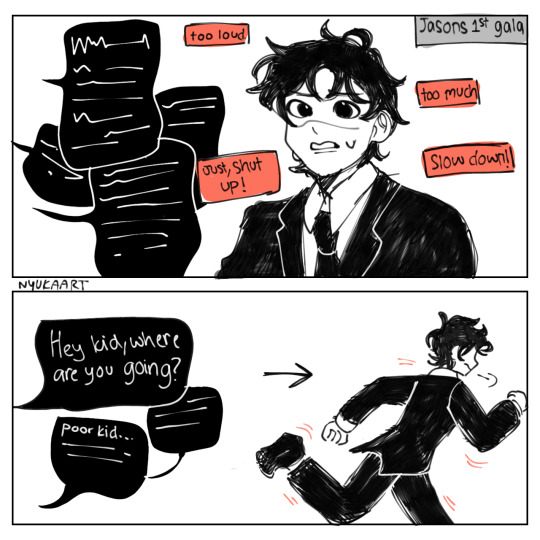


Lmao the panels are so unorganized
I like to think that each batkid had a different experience with their first Gala for example,
Dicks first Gala was hectic but he enjoyed the attention in a way,Bruce only brought him to a Gala a few months after he adopted him so he can settle down more. Dick enjoyed the attention for the most part,reminded him of performing again just.. socially
Jason was STRESSED. When more then 5 people tried talking to him ran away sobbing cause bro did not prepare for all that
Tim was pretty neutral,he'd gone to Galas before,maybe not as big but he just didn't really react as much,the most chill imo
Steph was having the time of her life,she started talking to all the media interviewers, thought it was funny how rich people think and act like (mimicked their behavior to fit in and hear about CEO gossip that she'll tell the others about)
Duke is a little stressed cause he expected big but not THAT big. He kept his distance from the crowd at first but slowly started talking more,he didn't mind but it wasn't the best experience
Cass was overwhelmed but she set her boundaries immediately and just left if someone didn't get the hint. Would go completely silent if someone annoyed her too much and they'd just back off
Damian is just looking down on everyone there but still keeps a slight face. He had to be constantly scolded for running his mouth too much . He'd just be starting his genuine opinion on someones outfit but it'd come off as offensive (he had to go through PR training)
Map appears and disappears through out the Gala, you see her talking to a big group of people then she's gone for like five minutes, but overall she thinks it's interesting to see how all the major socialites talking to one another
Barbara talks to a few people but mainly just chilled around and talked to Dick during her first Gala,they just did their own thing while the adults around them did theirs
5K notes
·
View notes
Text
gonna show u guys a little opalescent highlight hack i threw together today
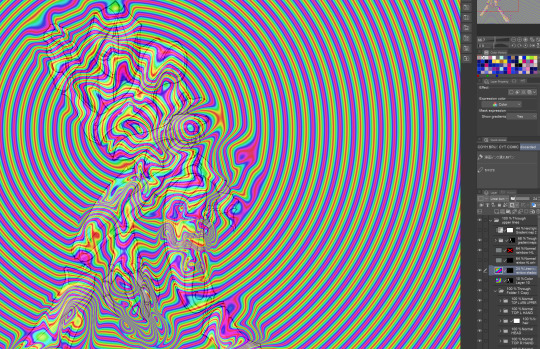
rainbow gradient above your main figure (i usually have all my main figure folders/layers in one big folder, so i can clip gradient maps + adjustments to it!). liquify tool to push the colors around a bit. STAY WITH ME I KNOW IT LOOKS STUPID RN I'M GOING SOMEWHERE WITH THIS
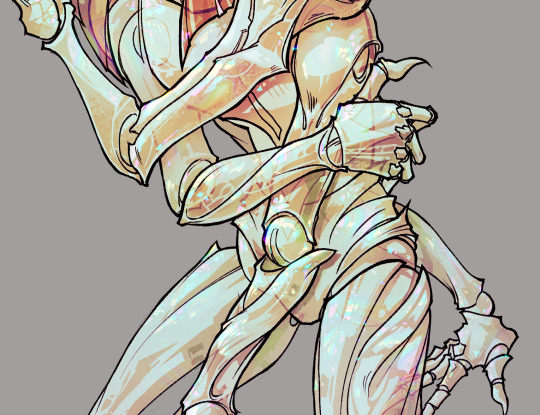
THEN: set it to add/glow (or the equivalent in ur drawing program), lower the opacity a bit, and apply a layer mask. then u can edit the mask with whatever tools you like to create rainbow highlights!!
in this case i'm mostly using the lasso fill tool to chip out little facets, but i've also done some soft airbrushing to bring in larger rainbow swirls in some areas. it's pretty subtle here, but you can see it better when i remove the gradient map that's above everything, since below i'm working in greyscale:
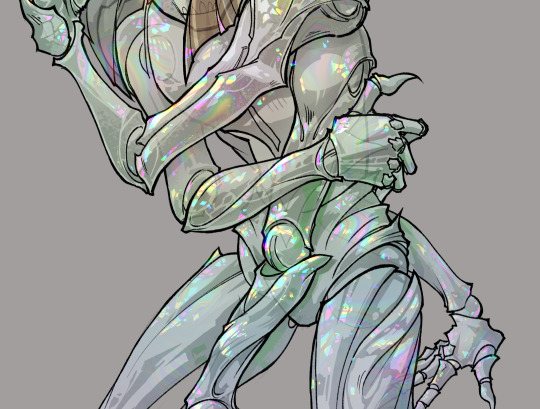
more granular rambling beneath the cut!
u could also just do this with a brush that has color jitter, but what i like about using layer masks for highlight/shading layers is how simple and reversible it makes everything. i can use whatever brushes i want, and erasing/redoing things is super low stakes, which is great when i often approach this stuff with a super trial-and-error approach.
example: have u ever thrown a gradient w multiple colors over an entire piece, set it to multiply etc, and then tried to erase it away to carve out shadows/highlights? it's super frustrating, bc it looks really good, but if u erase something and then change ur mind later, u basically would have to like. recreate the gradient in the area u want to cover up again. that's how i used to do things before figuring out layer masks!! but masking basically creates a version of this with INFINITE undo bc u can erase/re-place the base layer whenever u want.
anyway, back to rambling about this specific method:
i actually have TWO of these layers on this piece (one with the liquified swirls shown above, and another that's just a normal concentric circle gradient with much broader stripes) so i can vary the highlights easily as needed.
since i've basically hidden the rainbow pattern from myself, the colors in each brushstroke i make will kind of be a surprise, which isn't always great -- but easily fixable! for example, if i carve out a highlight and it turns out the rainbow pattern in that area is way too stripey, i can just switch from editing the mask to editing the main layer and blur that spot a bit.
also, this isn't a full explanation of the overall transparency effect in these screencaps! there's other layer stuff happening below the rainbow highlights, but the short version is i have all this character's body parts in different folders, each with their own lineart and background fill, and then the fill opacity is lowered and there's multiply layers clipped to that -- blah blah it's a whole thing. maybe i'll have a whole rundown on this on patreon later. uhhh i think that's it tho! i hope u get something useful out of this extremely specific thing i did lmao
12K notes
·
View notes
Text

sorry I know I’m being extremely annoying right now but the claim that the electronic calculator ‘did not forcibly pervade every aspect of our lives’ is so boldly and confidently wrong it’s impressive. the ability to automate the act of quantification (ie what an electronic calculator does) is probably as central to modern commerce and society as like, the transistor or the lightbulb. a world where excel spreadsheets do not exist is a fundamentally alien one to most people on planet earth. all geospatial software is built on the ability to do math on the fly. can you imagine the world today without google maps? can you even begin to comprehend a society not dominated by numbers? even these examples undersell how fundamental automated calculations are because this technology did in fact pervade every aspect of life. the fact that you think a calculator is simply a plastic doohickey you were taught to use in grade nine math is maliciously literal. like these arguments are so nakedly and openly anti-intellectual that I would say it makes it clear that no one should take you seriously, but posting this kind of mind-numbing slop is one of the easiest ways to do numbers on tumblr right now, which is something you also wouldn’t be able to do without the invention of an electronic calculator
3K notes
·
View notes
Text
Minecrafters Using Reference
Reference as in real world architecture, not other minecrafters' builds, though that's a fair way to learn too. Studying real world architecture gives insights about designing buildings, while studying other minecrafters would give insight into how to accomplish certain effects in Minecraft.
I didn't have more than passing interest in architecture before watching mcyt, but now whenever I'm outside, I'm evaluating the buildings around me. Do I like their shape? color? Any interesting details? Any wear or texture? And above all: How would you do that detail/shape/etc in minecraft? (please note: I don't even play minecraft)
Rendition and Inspiration
There's a minecraft project called BuildtheEarth that's replicating the earth in minecraft on a 1 to 1 scale. There's some fantastic builds on there.
On hermitcraft, Joe Hills is known for creating to scale renditions of real world places/objects. In season 10, he's tackled a project of massive scale with Bell Labs. He used a map from the library of congress to layout all the shapes!


These are examples of renditions/replicas/copies/whatever you want to call it (Although Joe's doubles as a community build area in place of massive parking lots).
Then there's using the buildings for inspiration. This may involve just taking bits and pieces. Or maybe you just take a color palette. Or maybe just the shape. Maybe you don't take anything but vibes. As a general rule, I think having multiple sources of inspiration is important so the new build doesn't end up feeling like a rendition instead of its own thing.
Bdubs in season 9 used the bakery from Kiki's Delivery Service as inspiration for his mud cafe. It can be seen in the wood framing, the stairs, the archway, the shape, the shed, the chimney designs. But the colors, the composition, Bdubs made changes that made it his own and combined the addition to his previous shop Moss o Menos.


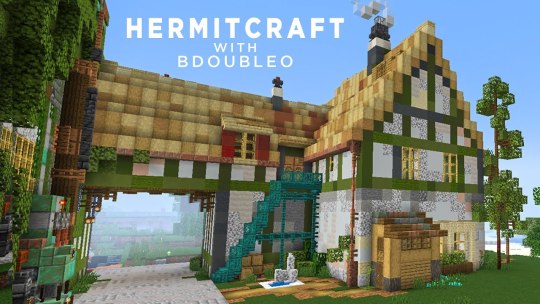
The aesthetics of Geminitay's season 10 base is based on the video game Dredge. I feel like the most obvious influence is in her research castle and fishing boats. She used inspiration from the spooky sea creatures in the game to create a uniquely frightening angler shop.

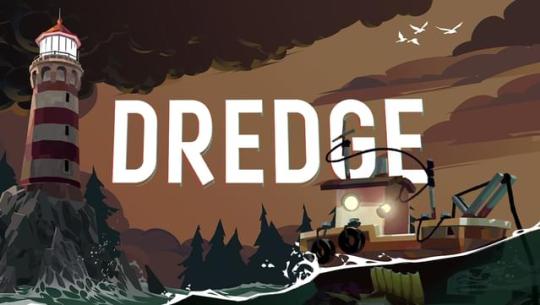
In Pearl's Build a Day series, she did a week focused on real world places. Here's the one she designed after a countryside home in Australia (her home country):


Goodtimeswithscar in season 7, when starting Aqua Town, based his shop on old department stores:


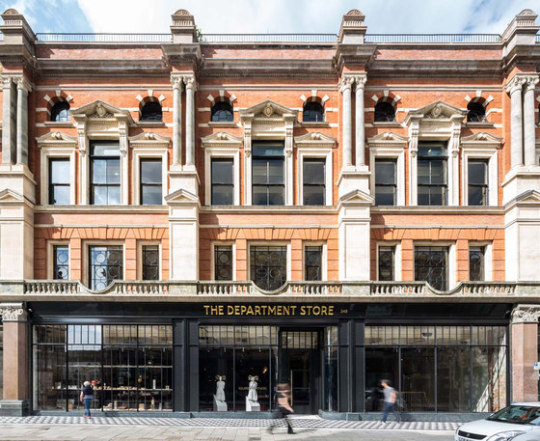
I like looking at his Aqua Town builds in comparison to his Scarland Main Street facades, which draw additional inspiration from Disneyland:





I feel like, comparing the builds you can see how he's grown; he's learned new detailing tricks, found colors and textures that work better with the architecture style. The main street has a similar layout to Disneyland, but his buildings are all unique.
Mogswamp is working on a massive build that's based on architecture drawings from Renzo Picasso:


He's incorporating groin vaults from roman architecture too!
I think builders learning about existing architecture is so good. It can give them so many ideas to add into their toolbox. It reminds them of small details that give builds life, like small sheds, some pipes, porches. And the builds don't need to be realistic; My mind goes to work by Shovel and Joel. Or everything Mumbo has done in season 10.
2K notes
·
View notes
Text
Other Misc. Rambling Thoughts on the topic:
(~ !!!!!!!!! if you're just reblogging this post for the Poll section, please reblog the original post without this addition* lol. ~)
(*not that there's anything super personal or weird about the addition, just that it's meant to be kind of casual Side Commentary, not really part of the Main Point Of The Poll, so it would feel kind of weird for it to be emphasized by being included in reblogs unless the reblogs were explicitly about the side commentary, etc..... if that makes sense.. ANYWAY!)
It's neat to read the written descriptions that people are mentioning in the tags, since it's almost like I can see or conceptualize the idea as well, but it's just.. I'm not SEEING it.
Like for example: I can imagine a vase, it's a muted mint green and slightly translucent, elaborate golden birds sprawled down the side in streaks of thin rough watery paint, the base material shimmers gently in the light, there's a small chip where it's cracked on the handle, etc, etc. .. But as I'm thinking about this I see literally nothing.
It seems like perhaps some people can visualize an object first, and THEN describe what they see. But I sort of work backwards. I am building the object in my mind, I can never see it, but it's a collection of concepts. Rather than visualizing all details as a whole at once, I am adding each detail one by one, building onto the IDEA of the thing.
The vase doesn't have a crack on the handle because I just automatically visualized a vase with a crack. It was more that I cognitively understand the concept of a vase, what they tend to be made out of, how they tend to look and feel, the properties they have. So based purely on that knowledge, I can imagine "a chip is something that a vase could have, it would look this way and behave this way" - more like... I'm constructing a bullet point Fact List about the object rather than seeing it.
So if you tell me to imagine an object, I can, in a way, imagine that object in great detail, but it's just.. I'm not SEEING those details, more just knowing it's qualities in a purely conceptual way. Sometimes in the tags when people are like "yeah I can see the skin of the apple, texture, little dots on the surface" it's like… I can imagine that too, I can know it's there, but just with no visual attached.
I guess rather than SEEING something and going ''ah. I know what this looks like because I have seen it''. I more just skip that visual step entirely and go ''I know what this looks like, I just randomly have a list of information about the concept in my mind.'' etc. Maybe similar to how sometimes in dreams, even though a house may look completely different and be in an entirely fake 'dreamlike' environment, you just somehow KNOW intuitively that it's meant to be your childhood home or something. Even when it looks nothing like it in reality. There's a built-in base knowledge of the properties or information of some things within a dreaming mind, etc.
--
This also makes me wonder about like.. how storytelling and myth is so important to cultures all across time. Or how this could tie also into concepts of religion.. etc. etc. If so many people really can kind of conjure these vivid images in their mind, then maybe that's part of why certain things are so meaningful to them? Like a "religious experience" being something you can actually really SEE/feel/lingering with you in your head, rather than just abstract words on a page, detached purely theoretical ideas, etc... hmmm
.
Plus also just for average emotional stuff too, even outside of broader cultural conceptual attachments..
Like, I don't think there's a direct 1 to 1 link (obviously not all people with mental illnesses that significantly reduce their emotional or expressive capacity also MUST have aphantasia or vice versa), but it's interesting as someone who DOES also have a much more lessened emotional range/pretty flat affect/etc. etc. to think like.. Maybe I WOULD be more emotional, in a way, if I could have these vivid experiences..?
Perhaps memories would hold deeper significance if they could really stay with me vividly. Or storytelling would evoke more of a deep emotional reaction to me if I could really picture and feel the things that are going on. If things were more TANGIBLE in my brain, rather than always merely conceptual highly abstracted ideas.
Kind of like, it's probably easier to get over the death of a pet or something, if after not seeing them for an hour you already don't remember what they looked like (beyond just a vague fact list of traits), and you have no vivid memories or mental reminders of them (beyond just factual information stores). COGNTIVIELY you can appreciate the idea of their absence, of course, you still miss them, but there's just no remaining visceral sensory ties. A very "out of sight, out of mind" sort of thing in terms of attachments, memories, emotions, etc. Maybe certain things are easier to "get over", when you're not having constant mental sensory reminders that occasionally rekindle your feelings about the event or etc.??
(like for example, maybe someone could remain angry about an argument longer if they could vividly replay it in their head over and over again. VS just like.. 'Yes I can factually recall the fact I had an argument, and I do have knowledge stored about what precisely was said, but any sort of sensory data such as sights/smells/feelings, etc. from the actual moment of the event are long gone and can never be conjured again in my mind." etc.)
Which again, I think lessened emotional permanence and image permanence in the mind are NOT inherently linked, can all be caused by different things for different people. And, since I can't visualize anything in my head, maybe I'm misunderstanding how it happens and the effect it may have on stuff like remembering things you miss or replaying arguments, etc. etc. But it's still a little interesting to think about, if they could influence each other to some degree.... :0c --
Lastly, It's also weird because I'm actually pretty good at estimating distance and spaces? I can quickly assemble furniture without an instruction manual, pretty easily have a concept of how much space a chair may take up in a room, how two mechanical parts might fit together - BUT, I am literally not actually visualizing anything. I cannot see 3D objects in my mind at ALL. It's like.. just based on the pure List Of Facts About Things Which I Have Observed.. I can intuitively go "oh this works like this/this is this size" just because.. I know it's that size. I don't have to see anything to know..?
But then on the other hand, I'm terrible at directions without a map (I guess because a 3d outdoor environment has WAY more complexity than like.. "Will this square fit into another square?"etc. lol ).
BUT, I also draw/sculpt/etc. entirely without references, and seem to do mostly okay at that..? Like.. I can't even remember the last time I actually used a reference or looked at anything whilst drawing. It's all muscle memory, and me just adjusting as I go until something "looks right" on paper, I never have a set image in my head (or external reference) before hand.. Hrmm....
AND.. I used to say that I had a photographic memory when I was younger, which I know NOW is not true (I always thought it was just an expression, not that people could literally see things in a photographic way). But what I was describing is, I do often associate information with imagery, just... without imagery....
Like "Oh, I know that I took my medicine earlier today because I have a distinct memory, a snapshot of a moment in time, of me rattling the pill bottle in my hands as I looked up at a stop sign while in the back seat of a car". When I say this, I can't ACTUALLY see/feel/hear a pill bottle, or vividly picture a stop sign, but it's more just a factual recall, of. Even though I don't see these things, I know they happened, the information of them happening (me hearing a sound and also looking at a stop sign at the same time) has been stored in my brain as a memory, a collection of linked facts. --
As for other senses, I cannot taste or feel anything in my head AT ALL.. wild that some people mention that. I mean, again, I can have a purely factual recall as if reading a textbook, knowing the information of 'X item typically has X texture, therefore I can imagine what it may be like to feel it' or 'X usually has this taste' etc. - but I can never actually experience those senses in any capacity in my mind alone. I would say audio is my strongest mental sense (maybe a 2.5 or 3 (if it were translated onto the above scale where 1 is most vivid and 5 is nothing)), then visual (4.5 at most, usually 5), and then taste and smell and such are just complete 5, absolutely nothing, I didn't even know people could experience taste or feeling just in their mind alone.. lol...
I know this is just a silly bad quality random screencap of a screencap that I found on facebook lol, BUT it's a succinct enough image to easily describe the concept in a quick/accessible way hopefully :
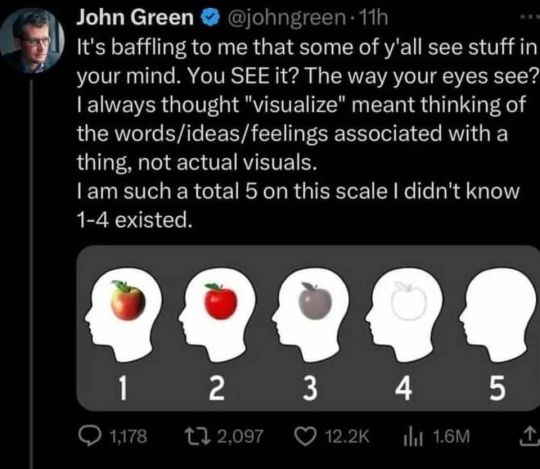
-
(and of course, feel free to elaborate in tags, etc.! (especially elaborating about other senses as well.. can you "hear" in your mind just as well as you can "see"? taste? etc.) It's an interesting topic to me, as someone who's like a 4.5 at MOST lol. I'm curious what option will be the most common :0c )
#repeat reblog#Hrmm.... this must be why you all like reading books so much lol… option 5.. so few of us…#Also I wonder if this is why I'm a more detail oriented writer. Like if I was making a story I would first have to plot out information#about the location. draw a map of the room the chararcters are in. sketch the characters. their outfits. do a lot of plotting and planning#about how the world and the setting works and what plants might be there and so on and so forth. Because I'm working#more from a factual knowledge base of like 'bullet point list of things I know about this setting/object/person/etc'#rather than actually just being able to see it in my mind. So to really conceptualize a person/place/thing - I have to build it#from the ground up conceptually. Gathering and organizing all the information about it until I have a Full Mental Concept of it - and THEN#I can work with it from there. But maybe someone who just Pictures all that in their brain from the beginning can kind of skip that step.#Like for example I literally have NO idea what any of my characters look like until I draw them. I have to actively decide what they look#like and think about all of those details and create the List Of Factual Information (black hair. green eyes. this tall. etc.) from scratch#. where the friend I talked to on the phone recently said that they literally just like... picture the character. like they just SEE them#doing stuff and know from there. And of course i have an IDEA of what I may want a characters appearnce to be or properties that would suit#them based on their Concept and Personality. but I literally do not know. And even when writing or thinking about characters doing things#I cannot visualize them no matter how hard I try. It's all theoretical factual recall for me. Also my friend said that to THEM the saying#''the characters write themselves'' was interpreted to mean.. they can literally sit down & watch the characters do things and it's as#if they are just creating a story in their mind from thin air. it writes itself. Where for ME I have always interpreted it to mean ''I have#undertaken the process of analyzing and plotting every detail of this character SO deeply that I know them SO well down to even#how they would walk or hold a pencil. and thus because I have such an intimate understanding of every intricacy of their personality. It's#extremely easy to just Put Them Into A Situation and assume exactly how they'd react/ exactly what they'd say because based#on what has factually been determined about them and their personality/worldview/etc. it's just.. literally automatic. The same way that#if you knew a friend's preferences extremely well you could probably easily predict how they'd respond to a birthday gift'' etc.#hmm.. ANYWAY... Which my friend may be an extreme example. I feel like it'd be obvious even for writers without aphantasia to STILL sit#down and plot out details & intimately understand their characters/setting/etc. But the idea that for ANYONE it's like ''yeah I dont have t#think much about designing the layout of a room/place/etc. I just kind of SEE it in my mind and know automatically''.... wild... lol#It makes it seem like I'm always having to do like 500 tons of extra work that other people can just skip .. oughh#''well after writing them for a YEAR and fully conceptualizing their personality and going through 15 sketch drafts. i have FINALLY#decided on an appearance for my character'' ... ''erm.. i have been seeing my character since day 1.. what do you mean?'' ... lol#ANYWAY.. and thank you to those who have sent in asks abt your experiences.. very inchresting.. sorry not posting/responding yet since im#still a bit sick feeling and energy is very scattered/low social ability/etc... even this post i typed over the course of days lol..
551 notes
·
View notes
Text
Book Decoration: AKA All The Ways I Don't Use a Cricut
(this post is for people who don't want to buy an expensive cutting tool, or for those that do have an expensive cutting tool that would like to mix things up a little)
1. Print That Shit
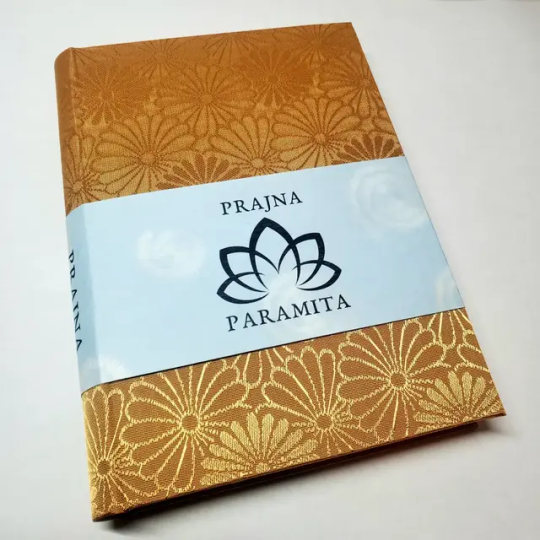
If you're already printing your own textblocks, an easy step for titles is to print them. Above is a title printed onto an "obi" of decorative paper. I measured out where I wanted things on the finished book and laid it out in Affinity, then printed it on a full sheet & trimmed it down to wrap around the book. A more simple method is to print & glue on the label into a slight indent in the cover (to protect it). A third option is to do the spine in bookcloth, while you print on paper for the cover and then glue that paper onto the boards (this usually looks even better when it is a three-piece bradel bind).
2. Foil Quill / Heat Pens
The heat pen is one of my go-to tools, but it can be a bit touchy about materials. The most popular version is the We R Memory Keepers' Foil Quill (which is one of the most ergonomic), but other pens exist that can get you to a higher heat temp, finer lines, or more consistent foil. For example, I have a pen created by a local Japanese bookbinding studio that fares way better on leathers than the WRMK quill & with a finer tip, but it's hell to control. Best results in general are on paper or smooth bookcloth (starched linen, arrestox, colibri - even duo will work but its less solid). The fuzzier a bookcloth is, the less your foil quill wants to deal with it. This means the heat n bond method of making bookcloth does not play nice with a heat pen usually, but there are two solutions: 1) use this tutorial on paste + acrylic medium coated bookcloth instead that will get you a perfect surface for the heat pen, or 2) use the pen on paper & then glue onto the cloth. I did a video tutorial for both foil quill use and this type of homemade bookcloth for @renegadeguild Binderary in 2023.
You get the most consistent results by tracing through a printed template that is taped in place, as I do in the video above.
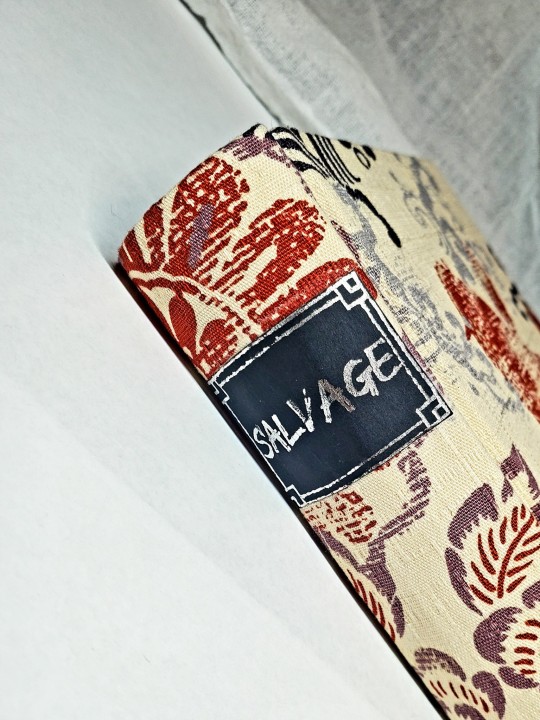
3. Paint That Shit
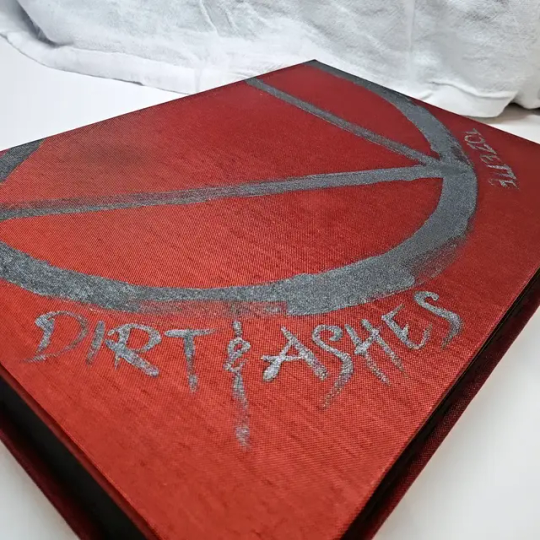
Acrylic paints will do you fine! The above is free-handed with a circle template, because I wanted that vibe. If you need straight lines that won't seep, lay them down with tape first & then paint over it first with a clear Acrylic medium, then your color. Same goes for stencils. Two more examples of painted bookcloth:
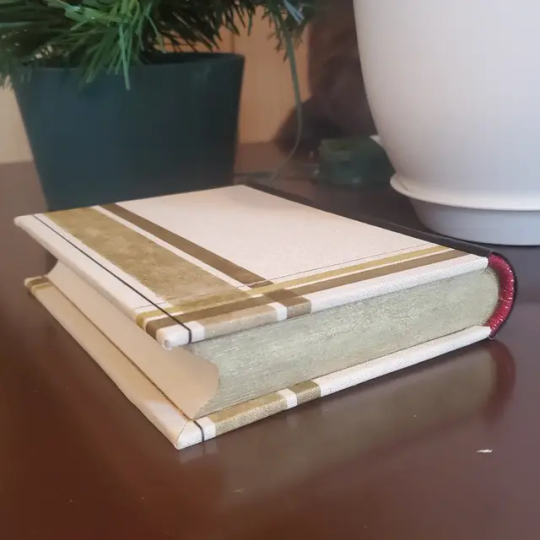
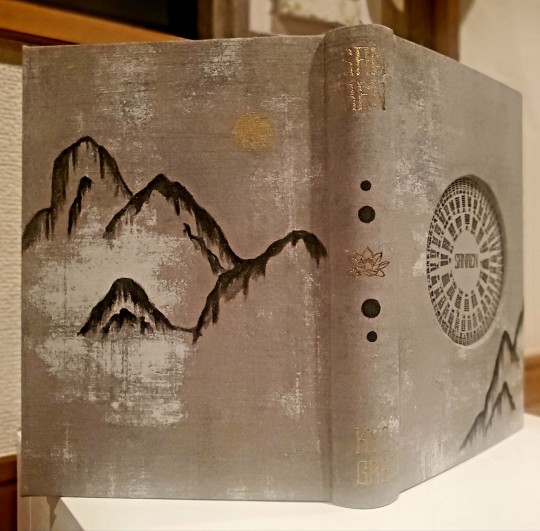
4. IT'S GOT LAYERS
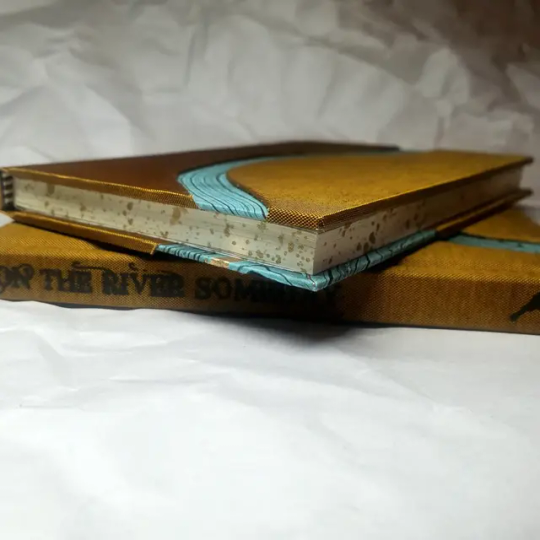
By using layers of thinner boards, you can create interesting depths & contrasts on your cover. You can also make cutouts that peep through to the decorative paper behind. The most important part to this technique is the order in which each edge is wrapped. To get a good wrapped inside edge, you will split the turn in into tabs to get them to conform to a curve. You can also layer multiple colors of bookcloth without multiple layers of board, as seen below left, so long as you mind your cut edges for fraying.
5. Inlaid... anything
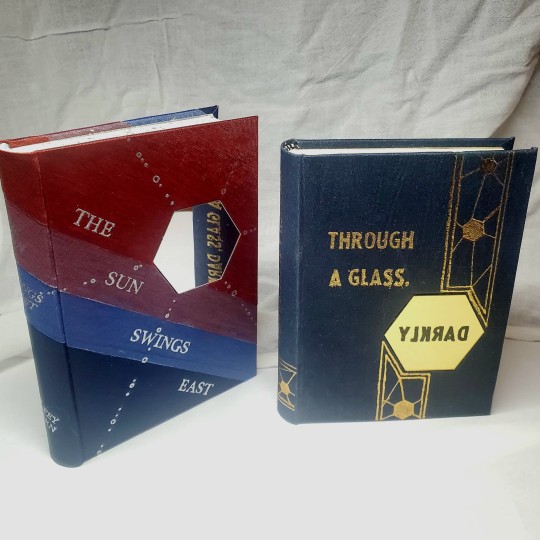
Mirrors! Marbled paper! I saw someone do a pretty metal bookmark once! The key is creating a little home for it to live in, which is pretty similar to the above layering method. On one layer you cut the shape, & glue that layer onto the bottom solid board before covering. You can do the top layer as an entire 1 mm board (like I did for the mirrors) or a sheet of cardstock, like I would use for inlaid paper.
6. Decorative Paper
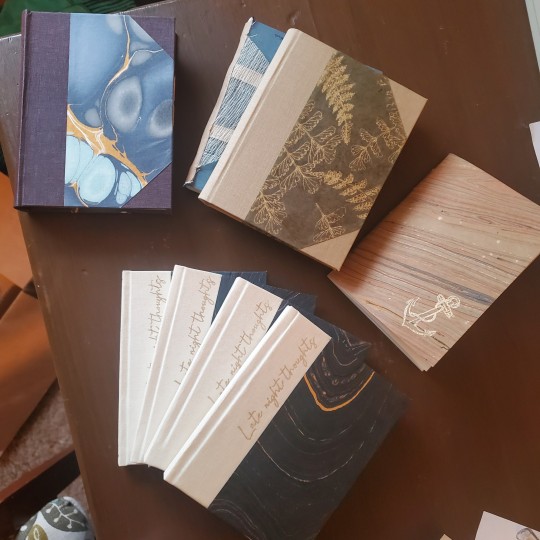
Decorative paper is always helpful & adds to the paper hoard... & its effects can be layers with other techniques, as below. Marbles, chiyogami, momi, or prints & maps of all kinds can be great additions. Some papers may need a protective coating (such as wax or a sealer).
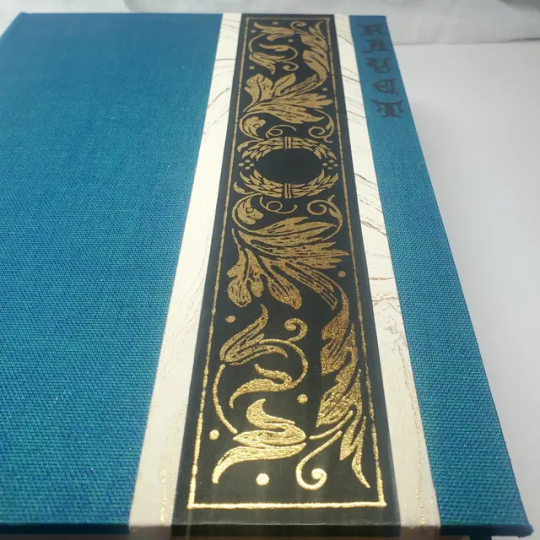
7. Stamps (with optional linocut)
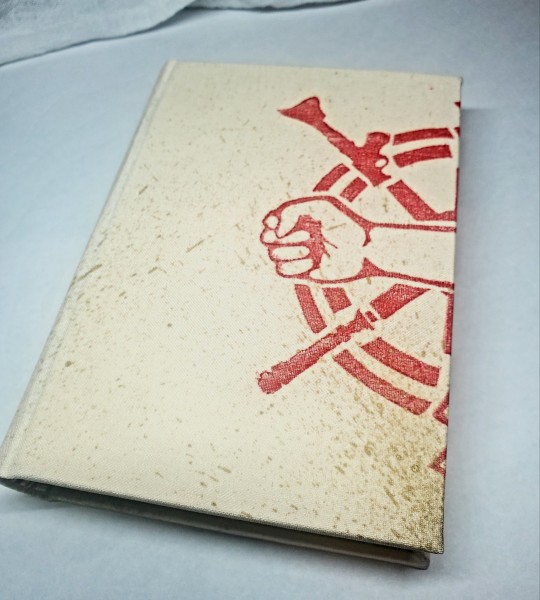
While I've not used many more regular rubber stamps, I do know some who have, successfully! And I've used one once or twice with embossing powder (see photo 3 up, the gold anchor on the little pamphlet bind). What also works is to carve your own linocut or stamp, & then use block printing ink to ink it onto your fabric (as i did above). A bit time intensive, but it was nice how easily reproducible it was, and I liked the effect I got for this particular bind.
These methods are not exhaustive, just ones I've used, and there are of course many others. I haven't gone too into detail on any of these for the sake of length (& post photo limits) but feel free to ask about more specifics. Usually I'm using them in combination with other options.
#fanbinding#bookbinding#celestial sphere press#ficbinding#in progress review#bookbinding how to#i am not particularly anti-cricut or anything#it's just a very expensive tool#and its prevalence sometimes makes new binders think they HAVE to get one#when they absolutely do not#you can make pretty books without it
1K notes
·
View notes
Text
Subtle ways to serve the patriarchy in your daily life:
1. Be respectful
When talking to strange men, always refer to them as "sir" or as a "gentleman." This may seem outdated, but some people still talk like that. It shows your respect and harkens back to a time when men were in charge and women knew their place.
2. Be polite
Always say please and thank you, even if it doesn't seem necessary. For example, instead of saying, "Hey, do you know where the restroom is?" say, "Excuse me, sir, could you please show me where the restroom is?"
3. Be dependent
If you go out with a man, let him hold your phone. He'll decide what you need to see and who you need to communicate with. If he goes through your texts and photos, that's his right.
4. Be a doll
If you go out with a man, let him choose your outfit, how you do your makeup, and your hair. Don't leave until he is completely satisfied with your appearance.
5. Dress to impress
If you go out without a man, choose makeup and an outfit based entirely on what you think men find attractive. (Unfortunately, you will have to use your brain just a little bit for this one 😥) It doesn't matter if you like it, or if it's comfortable, men's taste is your taste.
6. Be helpless
If you think you might need help with something, ask a man. Even if you think you could probably do it on your own, remember that you can't. If you're lost, don't try to use Google maps. Ask a man for help. If there's something wrong with your car, don't even try to figure out what it is, take it to a mechanic, and say, "It makes a weird noise when I do this" and let him handle everything for you (ideally you wouldn't be driving at all)
7. Be approachable
If ANY man flirts with you or compliments you, be receptive. If a dirty homeless man says you have nice tit's, smile at him and say, "Thank you, sir." If a group of men are hollering at you, stick around, give them a spin so they can see and judge every part of your body, invite them to come over and grope you.
8. Be submisive
Never talk back to a man. If a man is rude to you, be grateful for the attention and ask him what you can do to make it right.
9. Be dumb
Don't use big words, in text or in speech. If you have an idea that you don't know how to express, it's probably too complicated for you. Only read when you have to. Never try to understand current events, occupy your mind with porn. If you really need more intellectual stimulation, you can watch something like celebrity gossip news.
10. Spead the word
Subtly try to teach other women their place, compliment them on their appearance, and nothing else. Discourage them from valuing things like their education and career. Encorage them to dress more slutty, if possible get them drunk and makeout with them for men to watch.
#bimboification#dumb puppy#bimbo training#patriarchy kink#bdsmkink#bdsmblog#bimbo doll#dumb slvt#cnc free use#degrading k1nk#degredation kink#dumb wh0re#r@pe fantasy#c0cksleeve#human fleshlight#fr33use
3K notes
·
View notes
Text
Tips for building immersive plots
1. Start with your core idea
• Every plot begins with a spark—a question, a concept, or a character. Build from that seed.
• How? Ask, "What excites me about this story?" and focus your energy there.
• Example: A story about a magical curse could explore themes of redemption or betrayal.
2. Brainstorm freely
• Don’t start by thinking about structure. Instead, write down every idea you have—plot points, character traits, world details—without judgment.
• How? Use mind maps, lists, or “what if” questions to expand your ideas.
• Example: “What if two rival kingdoms were forced to unite to stop a shared enemy?”
3. Map out key events
• Divide your plot into beginning, middle, and end, and identify major turning points. These events should shape the character’s journey.
• How? Use the three-act structure, or simply think in terms of setup, confrontation, and resolution.
• Example:
Beginning: A thief steals a sacred artifact.
Middle: The artifact begins to curse them, forcing them to seek help.
End: They must choose between keeping the artifact’s power or destroying it.
4. Plan with cause and effect
• Immersive plots follow logical progression. Ask yourself: “What happens because of this event?” for every key moment.
• How? Make sure each event impacts the characters or world.
• Example: A hero saves a village → the village leader reveals a secret about the hero’s past → this drives the hero to confront their estranged parent.
5. Flesh out your subplots
• Subplots add depth and make your world feel real. Tie them to the main plot for maximum impact.
• How? Use subplots to explore secondary characters, add emotional stakes, or introduce twists.
• Example: While on a mission to defeat a villain, the hero struggles to repair their broken friendship with their ally.
6. use story beats to stay organized
• Break your story into smaller moments: inciting incident, midpoint twist, climax, resolution.
• How? Write one sentence for each beat to outline the flow of your story.
• Example:
Inciting incident: A cursed item bonds to the protagonist.
Midpoint: They discover the curse is tied to a powerful enemy.
Climax: They must sacrifice their freedom to destroy the curse.
7. Think of immersive twists
• Twists keep readers engaged and make your story unforgettable. They should feel earned, not random.
• How? Ask, "What would surprise the reader but make sense in hindsight?"
• Example: The mentor helping the hero turns out to have caused the conflict in the first place.
8. Build emotional stakes
• Plot isn’t just about events—it’s about how those events affect your characters. The stakes should feel deeply personal.
• How? Tie the plot to your protagonist’s fears, desires, and growth.
• Example: A hero who’s afraid of failure is forced to lead a mission where the cost of failure is catastrophic.
9. Create a planning routine
• Writing immersive plots takes time and refinement. Set aside regular sessions to brainstorm, refine, and test your ideas.
• How? Use tools like storyboarding, sticky notes, or apps like Scrivener to organize your ideas.
• Example: Start each session by reviewing your previous notes, then tackle one section of your plot.
10. Test your plot
• Once you’ve mapped out your story, summarize it to see if it holds together. Does each event flow logically? Are the stakes clear?
• How? Share your outline with a friend or writer’s group for feedback.
• Example: “A reluctant hero must destroy a magical artifact to save their world, but doing so will cost them their memories.”
Follow for more!
#writeblr#writer stuff#writers on tumblr#writerscommunity#writing#novel writing#tips#writing tips#creative writing#writers and poets
859 notes
·
View notes
Text
Is Israel a Settler Colonialist State?
The claim is made so often that it's hard to fault people for believing it without much thought.
Let's first look at what Settler Colonialism is, then look at the facts to see if Israel fits the definition.
What Is Settler Colonialism again…?
It’s a specific term used by historians and theorists (Patrick Wolfe and his whole "logic of elimination" thing). Features of Settler Colonialism include:
Expansionism, claiming land for its mother country/empire (monopole) and shipping natural resources back to the empire.
Foreign settlers move in to violently displace, erase, or replace the indigenous population.
Any other cultures in the land are suppressed or wiped out
Classic examples include: British Australia, French Algeria, Canada, and North America
Let’s see if the case of Israel demonstrates these features.
A Franchisee?
Settler colonialism is usually a franchise model. Some imperial HQ says, “Go forth and colonize!” and ships people over with guns, flags, and an expectation to reap wealth torn from the colonized.
The Zionist movement started as a grassroots effort by Jews who were tired of getting pogromed every other Tuesday. Sure, they got a nod from Britain in the form of the Balfour Declaration, but that’s a long way from imperial orchestration.
(While Britain controlled Palestine under the Mandate, it hardly coddled Zionist aims - especially after the 1939 White Paper, which locked Jews out even as the Holocaust raged. Zionists didn’t march under imperial flags; they were often clashing with them.)
Settler colonialism involves one imperial power shuttling in settlers from a single source. But Jewish immigration to Israel? It came from everywhere: Yemen, Iraq, Morocco, Poland, Russia, Ethiopia, Argentina, Brooklyn…everywhere in the Diaspora.
This wasn’t a colonial outpost of one empire. It was a chaotic, desperate, and diverse ingathering of people trying to survive and rebuild. Half the Jews in Israel today descend from communities that were literally kicked out of Middle Eastern and North African countries.
If it’s settler colonialism, it’s doing it very wrong.
Foreign Settlers?
Settler colonialism usually involves people showing up in a place they have zero connection to and declaring it theirs. Think: Europeans showing up in Australia and telling the Aboriginal peoples, “Nice continent—don’t mind if we do.”
Jews didn’t just randomly pick Israel from a drop-down menu. They’ve had a connection to that land for, oh, 3,000 years or so. Jerusalem isn’t just spiritually significant; it's central. They didn’t have to invent a historical claim—it’s literally baked into their religion, language, and identity. (Quick Hebrew lesson: “Zion” is kind of a giveaway.)
Jews have maintained a continuous presence in the Land of Israel for over 3,000 years, including communities in Jerusalem, Safed, Hebron, and Tiberias, long before modern Zionism emerged.
Calling Jewish return to Israel “settler colonialism” is like calling your grandma a squatter for moving back into her childhood home.
But What About Palestinian Displacement?
Let’s be clear: Yes, during the 1948 war, a large number of Arabs living in Palestine were displaced. That’s a fact, it's not disputable, and it’s not something to brush aside.
This wasn’t, however, some settler-colonial master plan with color-coded maps and a mission to erase or ethnically cleanse non-Jewish peoples.
The early Zionist movement was buying land legally (much of it from absentee Arab landlords) and building farms, schools, and towns. It was a messy nationalist project, like many others in the 20th century. The displacement of Palestinians came not from a blueprint for ethnic cleansing, but from a war.
The war was launched by neighboring Arab states who made no secret of their goal: to destroy the brand-new Jewish state before it could take its first real breath.
Five Arab armies invaded in 1948, and local Arab leaders, along with the invading forces, told many Palestinian Arabs to temporarily evacuate, assuring them they could return after the Jews were wiped out.
Things didn't go according to their plans, because Israel survived.
Historians like Efraim Karsh and Benny Morris document cases where Arab leaders advised evacuation and cases where displacement occurred amid battle. War is brutal, and real people paid the price.
The tragedy is real, but so is the context. The war wasn’t started by Israel. It was a war of survival that Israel fought while vastly outnumbered, outgunned, and surrounded.
And here’s a twist that is usually ignored in modern retellings:
The term Nakba - which today refers almost exclusively to Palestinian displacement, originally meant something else.
In 1948, Arab intellectuals like Constantin Zureiq used “Nakba,” meaning "catastrophe," not to mourn Palestinian suffering, but to describe the colossal failure of the Arab world to crush Israel. In his own words: “The defeat of the Arabs in Palestine is not a small downfall. It is a catastrophe in every sense of the word.”
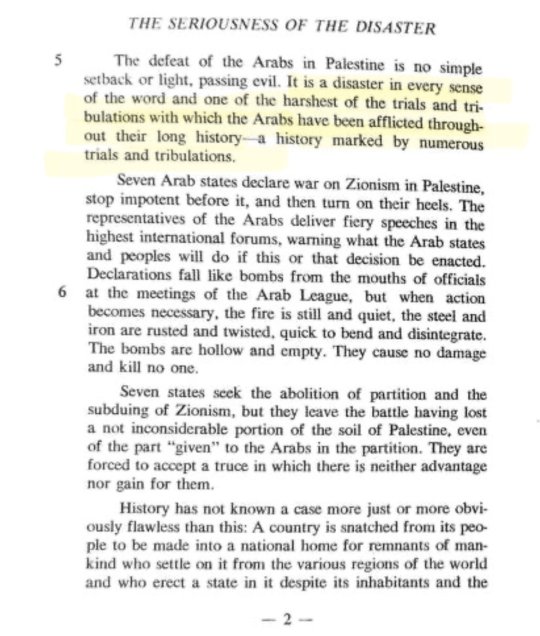
The shame wasn’t just about lost land—it was about how a supposedly mighty Arab and Islamic world failed to destroy a state of Holocaust survivors and refugees.
The original "Nakba" was about that failure, not the displacement narrative that would emerge decades later.
History is a lot more complicated than hashtags suggest.
But Israel Sought to Wipe Out Local Culture, right?
If Zionism had been a settler colonial project, you'd expect to see that. Settler colonial regimes tend to come in hot with cultural carpet bombing: banning languages, crushing customs, bulldozing identities.
Israel? Not so much. Israel has official protections for Christian, Muslim, Druze, and Baháʼí religious sites. Ever heard of the “status quo” agreements? They govern holy sites like the Church of the Holy Sepulchre and the Al-Aqsa Mosque. Unlike classic settler-colonial cases like the US, Canada, or Australia where indigenous languages, religions, and identities were suppressed, Israel recognizes Arabic as an official language, protects Muslim and Christian holy sites, and integrates minorities into public life with equal legal rights for all citizens.
Is the situation always perfect? No. Does Israel have a Ministry of Culture Death? Also no.
But Israel stripped the land of its natural resources in the name of their imperial project and destroyed the ecology of the land!
First, there was no empire, no monopole to ship anything to because (again) Israel was not the outpost of a foreign empire - it was a desperate refuge for Jews fleeing pogroms, fascism, and a genocide which had wiped out a third of their people.
Second, what natural resources could they have stripped the land of? Mandate Palestine was not known for its abundant natural treasures. Oil? Nope. Gold? Nada. Fertile, easily farmed land? Not much.
What Zionists did find was malaria, swamps, desert, and the occasional Ottoman tax ledger. The region was, in the words of Samuel Clemens (AKA Mark Twain), "a desolate country whose soil is rich enough, but is given over wholly to weeds."
Not exactly a paradise ripe for exploitation.
Here's a twist: rather than destroying the ecology, Israel has spent 75 years rebuilding it. The country has planted over 240 million trees, turning arid hills green and reversing desertification. Israel pioneered drip irrigation - watering crops with scientific precision to conserve every drop. It recycles nearly 90% of its wastewater (second place is Spain at about 30%). The Negev Desert is now home to solar farms, sustainable agriculture, and research centers where scientists grow cherry tomatoes in saltwater and build fish farms in sand.
Israel’s environmental stewardship of the land is so advanced that experts have come from Africa, South America, and India to partner with Israeli experts to tackle their own climate challenges. If this is what settler-colonial ecological destruction looks like, the planet could use a bit more of it.
So no, Israel isn’t extracting the land’s bounty and mailing it to a mythical European mothership. It’s been reclaiming wasteland, reforesting hills, and creating the most efficient water system in the world. And it did all that while fighting seven wars and inventing the USB stick. Not bad for a country the size of New Jersey.
It's a Colonial Struggle!!
It’s a nationalist conflict, not a colonial one. Two peoples - Jewish and Palestinian - with deep historic ties to the same land, both claiming national self-determination. That’s tragic, painful, and hard to resolve. But it’s not the same as a bunch of white Europeans setting up a Starbucks on someone else’s sacred mountain.
Trying to squeeze this conflict into the settler colonial box doesn’t make it clearer—it flattens it. It erases Jewish history and Palestinian suffering in one fell swoop.
History Deserves Better Than Hashtags
Calling Israel a "settler colonial state" might feel like a tidy moral label, but history is messier than slogans. The story is way more complex than “colonizer vs. colonized.” It’s about trauma, return, identity, nationalism, war, and a shitload of of mistakes along the way by all parties involved.
But if you want to understand it, really understand it, you’ve got to ditch the buzzwords and look at the footnotes, because the truth won’t always fit in a meme.
Aforementioned Footnotes:
Wolfe, Patrick. Settler Colonialism and the Elimination of the Native. Journal of Genocide Research, 2006.
https://www.kooriweb.org/foley/resources/pdfs/89.pdf
Veracini, Lorenzo. Settler Colonialism: A Theoretical Overview. Palgrave Macmillan, 2010.
https://link.springer.com/book/10.1057/9780230299191
Bickerman, Elias. From Ezra to the Last of the Maccabees. Schocken Books, 1962.
https://archive.org/details/in.ernet.dli.2015.59581
Biblical and archaeological records compiled in Israel
Finkelstein & Neil Asher Silberman, The Bible Unearthed, Free Press, 2001.
https://archive.org/details/bibleunearthedar0000fink/page/n5/mode/2up
Anita Shapira, Israel: A History (Harvard University Press): https://www.hup.harvard.edu/books/9780674047426
Jewish National Fund archives of land acquisition documents.
https://archives.cjh.org/repositories/3/resources/19702
Historical Aliyah data
https://www.jewishvirtuallibrary.org/total-immigration-to-israel-by-country-per-year
Protection of Holy Places Law, 1967
https://www.bu.edu/mzank/Jerusalem/tx/lawofholyplaces1967.htm
Shapira, Anita. Yosef Hayim Brenner: A Life. Stanford University Press, 2014.
(Documents Jewish labor ethos and rejection of exploitative structures)
https://archive.org/details/yosefhaimbrenner0000shap
On the Nakba
Benny Morris, The Birth of the Palestinian Refugee Problem Revisited:
https://yalebooks.yale.edu/book/9780300126969/the-birth-of-the-palestinian-refugee-problem-revisited/
Efraim Karsh, Palestine Betrayed:
https://www.jstor.org/stable/j.ctt1npnkg
Efraim Karsh, 1948, Israel, and the Palestinians – the True Story, Middle East Quarterly (2008)
https://www.researchgate.net/publication/258996946_1948_Israel_and_the_Palestinians_-_The_True_Story
Constantin Zureiq, Ma'na al-Nakba (1948):
https://archive.org/details/zurayk-nakba
_____
If you want to argue with this in the replies, please do- but bring receipts.
554 notes
·
View notes
Text
Bayverse!Donnie headcanons bc his my bbg
Okay, lol, I really needed to let all of this out and just vomit all the ideas I’ve been hoarding about this man. I love him. I’ve adored him ever since the 2012 series, and that made me realize—I definitely have a thing for nerds. And glasses. Dear god.
I hope you guys like this!! Do you think I should do the same for the other brothers? Or maybe for the other characters? (I wouldn’t mind taking the risk and making headcanons like this for Rocksteady, hehe.)
Alright, bye!!
warnings: sfw & nsfw ( but not so explicit?) :p
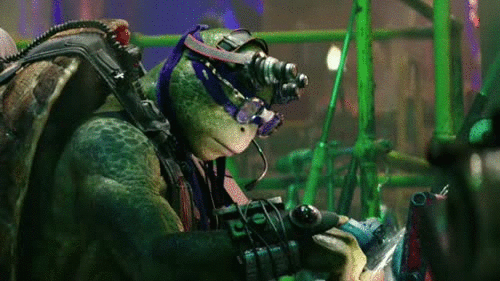
- He’s a genius with confidence… until he isn’t.
Donnie is incredibly self-assured when it comes to his intellect and skills. He knows his worth and never doubts his ability to solve problems. Jumping out of a plane without a parachute? Easy. Hacking government security systems? A piece of cake. But confessing his feelings to you? That’s a whole different challenge.
This is where his anxious side kicks in. His brain, used to solving any equation, completely short-circuits when it comes to emotions. What if he misinterprets your signals? What if he ruins the friendship? What if you like someone else? Sure, he can design an exoskeleton in less than 24 hours, but love is a field where variables don’t always make sense.
If you think you can hide something from him, think again. Donnie notices everything. From the slight shift in your expression when you’re tired to the pattern of songs you repeat when you’re feeling down. (And no, he absolutely did not hack your Spotify, ahem—)
- That’s why, when you start falling for him, he already knows. In fact, he probably figured it out before you did.
He won’t tell you right away. Inside his head, there’s a storm of chaotic thoughts, organizing themselves into an ultra-detailed data table with every relevant piece of information. Give him a few days, and once his mind has fully processed everything, he’ll come back to you as a renewed Donnie—determined, confident, and ready to make you his.
- Donnie doesn’t just plan things; he breaks them down into a thousand strategies of action. His trash bin is living proof of the number of ideas he discards and reworks over and over.
Gifts? He’s not the type to grab something generic at the last minute. His gifts are so deeply personalized that they’ll make you feel like he knows you better than you know yourself.
Example: If you ever casually mentioned that you’d love to learn to play an instrument, he’ll build one for you—customized with enhancements. If you said you love the stars, he’ll create an interactive star map with the exact alignment of the sky on the day you were born.
Your birthdays, anniversaries, and any special dates are planned years in advance. It doesn’t matter if you’re not officially together yet—he already has ideas saved for when you are.
- Romance in his brain is an equation far too complex.
Donnie isn’t clumsy because he lacks intelligence; it’s because his brain moves too fast. His emotions and logic are in constant conflict, creating an ongoing battle between Confident Donnie and Nervous Donnie.
You’ll see him go from saying something with complete confidence to, “Uh, well… what I meant to say is… no, wait, forget it—” and then getting frustrated with himself because that definitely wasn’t what he had in mind.
But when he manages to organize his thoughts, he’s one of the most direct people you’ll ever meet. Once he crosses the mental line of “I’m doing this,” there’s no turning back.
- Gifts
He doesn’t believe in generic presents. Everything he gives you has a specific purpose. A bracelet that’s actually a disguised tracker (“For safety. Just for safety.”), or a stuffed animal that can record voice messages.
One day, you wake up and find a new app on your phone with your name on it. You open it, and it’s a virtual assistant designed specifically for you, complete with personalized reminders for the little things Donnie knows you always forget.
- Once he has you, you are his priority.
Once Donnie accepts his feelings and takes the step to be with you, he becomes the most devoted boyfriend.
He’s not excessively clingy or jealous like Raph, but his love is obvious in the time and effort he invests in you.
No matter how many projects he’s juggling, if you truly need his attention, he’ll give it to you without hesitation.
- Donnie needs physical contact, but his intellectual pride won’t let him admit it outright. Instead, he prefers to justify it with overly precise scientific explanations.
“Well, you see… my body temperature tends to drop faster than that of the average human, so it’s biologically beneficial for me to share contact with an external heat source.”
Translation: “Hug me. Now.”
If you confront him with something like, “Why don’t you just say you want cuddles?” he’ll turn bright red and start stammering, scrambling for excuses.
Don’t listen. Just climb onto him.
- Donnie can plan everything, but he cannot predict your spontaneous displays of affection.
If you surprise him with a kiss, his brain completely shuts down for 3-5 seconds before he can process it.
Unexpected gestures—hugging him from behind while he’s working, cupping his face in your hands, or kissing his cheek out of nowhere—leave him frozen, recalculating.
Sometimes, his first reflex is to adjust his glasses, only to realize that they have nothing to do with the fact that his vision just blurred from sheer shock.
NSFW
- He’s patient… but only to a point. Donnie will never pressure you. He’ll wait as long as you need, always making sure you feel safe and comfortable.
However… he’s already undressed you with his eyes a million times.
His mind is a machine of ideas and theories, and when it comes to you, he has imagined everything. Everything.
He tells himself he can be rational and controlled… but if you take too long, his thoughts will become a little more persistent.
- He’s not innocent. Don’t even think it for a second.
He may seem shy or awkward about relationships, but when it comes to this, his mind is a laboratory of hypotheses he’s dying to test.
He has analyzed you with surgical precision. He knows exactly how you blush, how you react to certain touches, which words make you tremble.
Do not underestimate him. He has read, he has researched, he has learned.
But nothing compares to the real thing. With you.
When he finally has you in his hands, his brain short-circuits.
No matter how many times he imagined this moment, nothing could have prepared him for the feeling of your skin beneath his fingers.
His jaw clenches, he exhales sharply, and his pupils dilate as if he’s just been electrocuted.
His entire expression changes—from his usual nervousness to something darker, more intense, starving.
- He becomes obsessive about memorizing every single reaction of yours.
He’s analytical. He will learn what you love and make sure to do it better every single time.
Eye contact and sounds. His drug.
Look at him. Don’t look away. Don’t ignore him.
If you dare to hold his gaze while he’s above you, he will completely lose himself in you.
Your voice, your moans, your gasps—they ruin him.
He needs you vocal. He needs to know he’s doing a good job.
If you get shy and try to cover your mouth, he will ask (or demand) that you don’t.
Kinky? Oh, absolutely.
Donnie lives to experiment. It’s in his nature.
Positions? All of them. But his favorites are the ones where you are on top of him.
He loves being dominated.
After spending his entire life controlling every aspect of his world, it’s a relief for his mind to surrender completely to you.
“Set the pace, beautiful. I’m in your hands.”
Toys? Oh, yes.
You can be sure he has researched every single thing about them.
But he won’t settle for the ones that already exist. No.
He will build his own. Upgraded. With precisely calibrated speeds and optimized materials.
“This one has five vibration levels, but if we increase the frequency by 15%, we could—”
May God help you if you walk into his lab at the wrong time.
May God help his brothers if they ever find out.
Dedicated and obsessed with you.
Donnie doesn’t do anything halfway. If he gives himself to you, it’s completely.
No matter how much time passes, he will always give his all to make you feel incredible.
He’s not a casual lover.
He is yours. And you are his.
“You are my greatest discovery.”
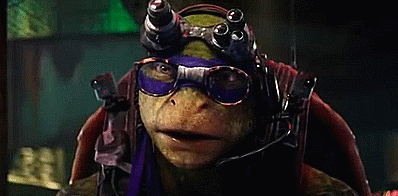
#tmntbayverse#bayverse tmnt#bayverse donnie#donnie x reader#bayverse donnie x reader#fluff#tmnt headcanons#reader#tmnt x reader
553 notes
·
View notes
Text
My Favorite Cheap Art Trick: Gradient Maps and Blending Modes
i get questions on occasion regarding my coloring process, so i thought i would do a bit of a write up on my "secret technique." i don't think it really is that much of a secret, but i hope it can be helpful to someone. to that end:

this is one of my favorite tags ive ever gotten on my art. i think of it often. the pieces in question are all monochrome - sort of.
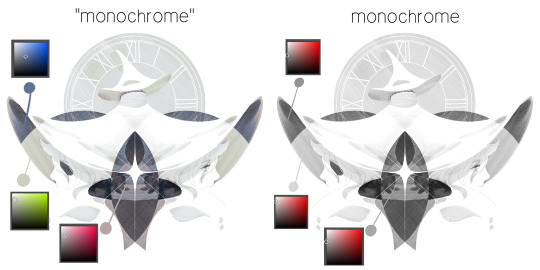
the left version is the final version, the right version is technically the original. in the final version, to me, the blues are pretty stark, while the greens and magentas are less so. there is some color theory thing going on here that i dont have a good cerebral understanding of and i wont pretend otherwise. i think i watched a youtube video on it once but it went in one ear and out the other. i just pick whatever colors look nicest based on whatever vibe im going for.

this one is more subtle, i think. can you tell the difference? there's nothing wrong with 100% greyscale art, but i like the depth that adding just a hint of color can bring.
i'll note that the examples i'll be using in this post all began as purely greyscale, but this is a process i use for just about every piece of art i make, including the full color ones. i'll use the recent mithrun art i made to demonstrate. additionally, i use clip studio paint, but the general concept should be transferable to other art programs.

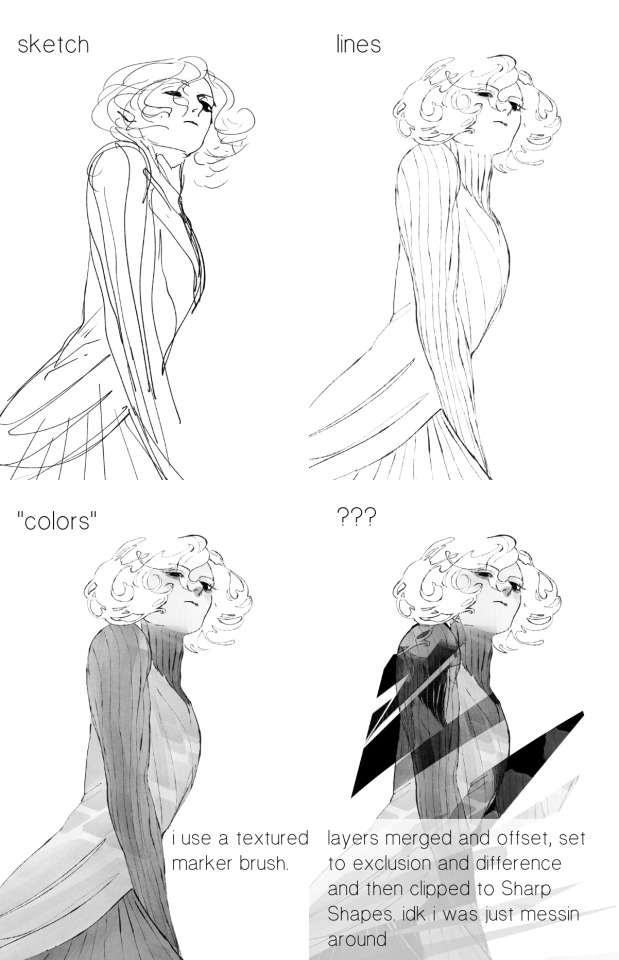
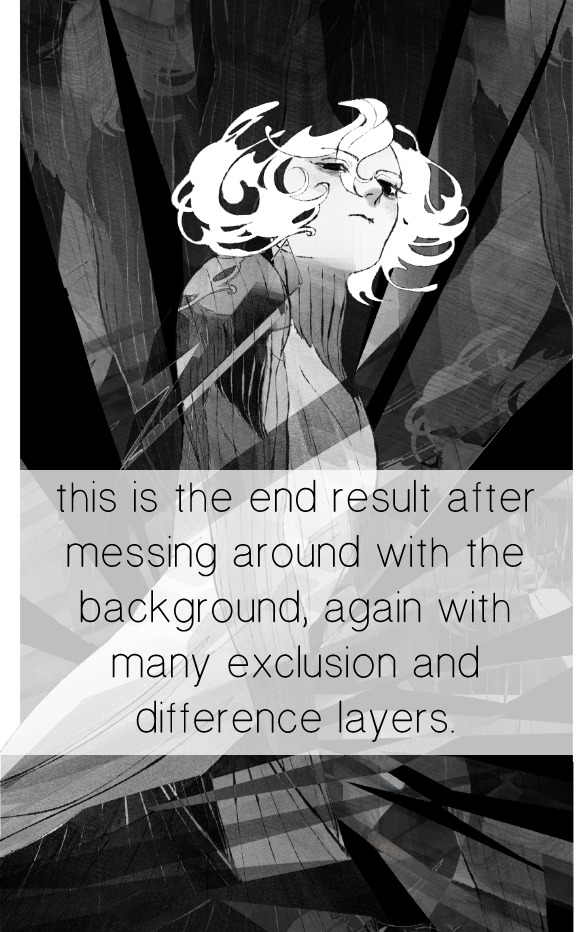
for fun let's just start with Making The Picture. i've been thinking of making this writeup for a while and had it in mind while drawing this piece. beyond that, i didn't really have much of a plan for this outside of "mithrun looks down and hair goes woosh." i also really like all of the vertical lines in the canary uniform so i wanted to include those too but like. gone a little hog wild. that is the extent of my "concept." i do not remember why i had the thought of integrating a shattered mirror type of theme. i think i wanted to distract a bit from the awkward pose and cover it up some LOL but anyway. this lack of planning or thought will come into play later.
note 1: the textured marker brush i specifically use is the "bordered light marker" from daub. it is one of my favorite brushes in the history of forever and the daub mega brush pack is one of the best purchases ive ever made. highly recommend!!!
note 2: "what do you mean by exclusion and difference?" they are layer blending modes and not important to the overall lesson of this post but for transparency i wanted to say how i got these "effects." anyway!
with the background figured out, this is the point at which i generally merge all of my layers, duplicate said merged layer, and Then i begin experimenting with gradient maps. what are gradient maps?
the basic gist is that gradient maps replace the colors of an image based on their value.

so, with this particular gradient map, black will be replaced with that orangey red tone, white will be replaced with the seafoamy green tone, etc. this particular gradient map i'm using as an example is very bright and saturated, but the colors can be literally anything.
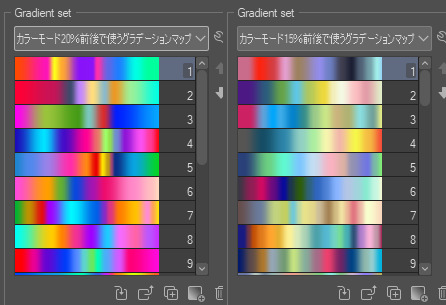
these two sets are the ones i use most. they can be downloaded for free here and here if you have csp. there are many gradient map sets out there. and you can make your own!
you can apply a gradient map directly onto a specific layer in csp by going to edit>tonal correction>gradient map. to apply one indirectly, you can use a correction layer through layer>new correction layer>gradient map. honestly, correction layers are probably the better way to go, because you can adjust your gradient map whenever you want after creating the layer, whereas if you directly apply a gradient map to a layer thats like. it. it's done. if you want to make changes to the applied gradient map, you have to undo it and then reapply it. i don't use correction layers because i am old and stuck in my ways, but it's good to know what your options are.

this is what a correction layer looks like. it sits on top and applies the gradient map to the layers underneath it, so you can also change the layers beneath however and whenever you want. you can adjust the gradient map by double clicking the layer. there are also correction layers for tone curves, brightness/contrast, etc. many such useful things in this program.
let's see how mithrun looks when we apply that first gradient map we looked at.

gadzooks. apologies for eyestrain. we have turned mithrun into a neon hellscape, which might work for some pieces, but not this one. we can fix that by changing the layer blending mode, aka this laundry list of words:

some of them are self explanatory, like darken and lighten, while some of them i genuinely don't understand how they are meant to work and couldn't explain them to you, even if i do use them. i'm sure someone out there has written out an explanation for each and every one of them, but i've learned primarily by clicking on them to see what they do.
for the topic of this post, the blending mode of interest is soft light. so let's take hotline miamithrun and change the layer blending mode to soft light.

here it is at 100% opacity. this is the point at which i'd like to explain why i like using textured brushes so much - it makes it very easy to get subtle color variation when i use this Secret Technique. look at the striation in the upper right background! so tasty. however, to me, these colors are still a bit "much." so let's lower the opacity.
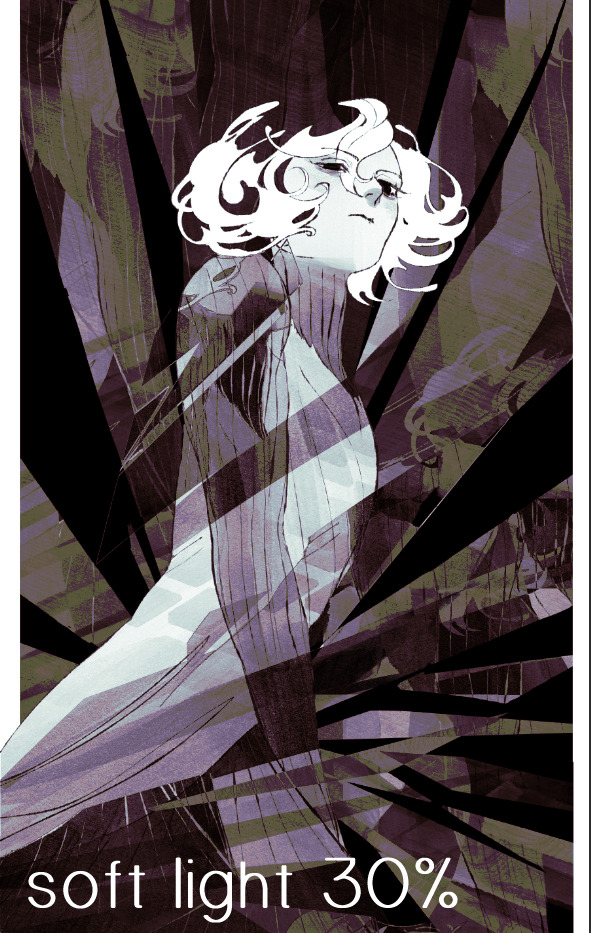
i think thats a lot nicer to look at, personally, but i dont really like these colors together. how about we try some other ones?
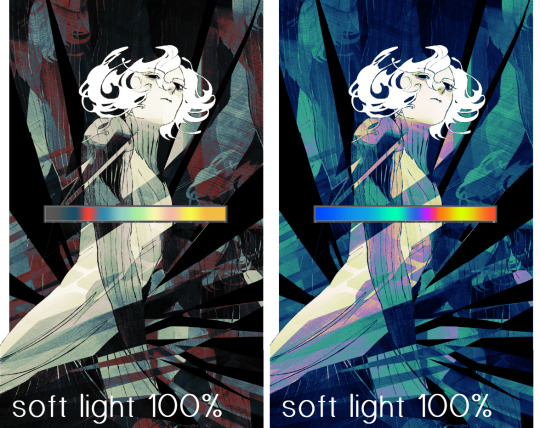
i like both of these a lot more. the palettes give the piece different vibes, at which point i have to ask myself: What Are The Vibes, Actually? well, to be honest i didn't really have a great answer because again, i didn't plan this out very much at all. however. i knew in my heart that there was too much color contrast going on and it was detracting from the two other contrasts in here: the light and dark values and the sharp and soft shapes. i wanted mithrun's head to be the main focal point. for a different illustration, colors like this might work great, but this is not that hypothetical illustration, so let's bring the opacity down again.
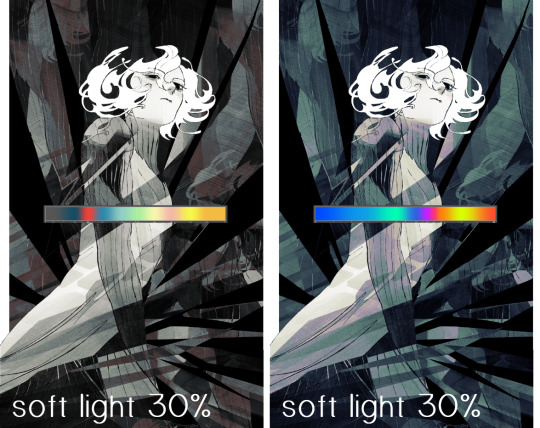
yippee!! that's getting closer to what my heart wants. for fun, let's see what this looks like if we change the blending mode to color.
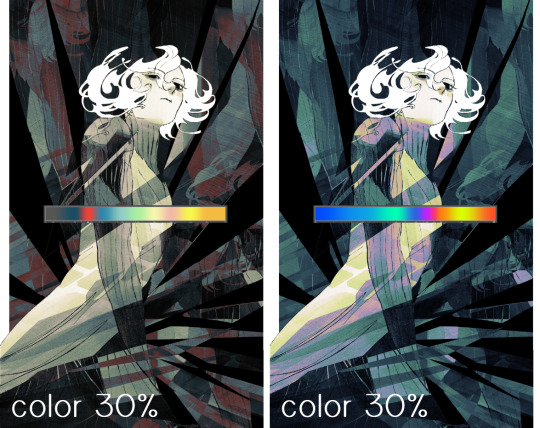
i do like how these look but in the end they do not align with my heart. oh well. fun to experiment with though! good to keep in mind for a different piece, maybe! i often change blending modes just to see what happens, and sometimes it works, sometimes it doesn't. i very much cannot stress enough that much of my artistic process is clicking buttons i only sort of understand. for fun.
i ended up choosing the gradient map on the right because i liked that it was close to the actual canary uniform colors (sorta). it's at an even lower opacity though because there was Still too much color for my dear heart.
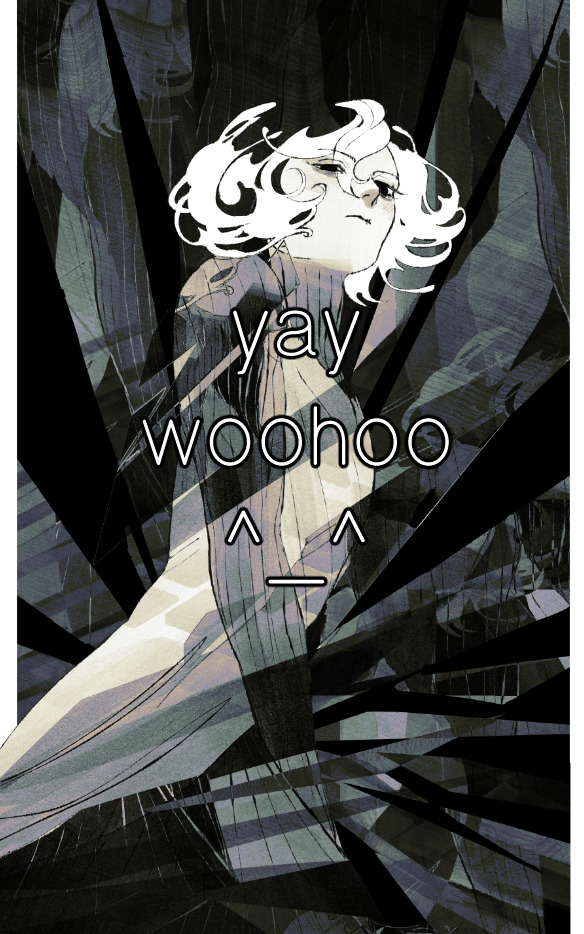
the actual process for this looks like me setting my merged layer to soft light at around 20% opacity and then clicking every single gradient map in my collection and seeing which one Works. sometimes i will do this multiple times and have multiple soft light and/or color layers combined.
typically at this point i merge everything again and do minor contrast adjustments using tone curves, which is another tool i find very fun to play around with. then for this piece in particular i did some finishing touches and decided that the white border was distracting so i cropped it. and then it's done!!! yay!!!!!
this process is a very simple and "fast" way to add more depth and visual interest to a piece without being overbearing. well, it's fast if you aren't indecisive like me, or if you are better at planning.

let's do another comparison. personally i feel that the hint of color on the left version makes mithrun look just a bit more unwell (this is a positive thing) and it makes the contrast on his arm a lot more pleasing to look at. someone who understands color theory better than i do might have more to say on the specifics, but that's honestly all i got.
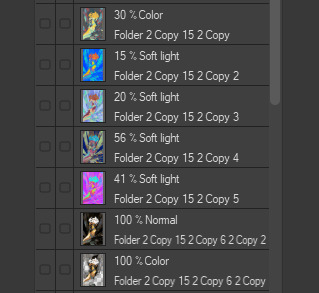
just dont look at my layers too hard. ok?
2K notes
·
View notes
Text
Writing Notes: Detailed Settings

A detailed setting draws your readers into the world you’ve built, allowing them to inhabit the storyline. Learn the core elements of setting, and apply them to your own writing.
How to Create a Vivid Setting for Your Story
Writing vividly is all about evoking clear imagery and detail in the mind of the reader. Here’s how to create a richly textured world for your story:
Use place to your advantage. Place denotes both geographical location and immediate surroundings. A story that unfolds in the hurried chaos of New York is not the same if transplanted to an isolated island in the Pacific. A scene that takes place in a cramped room shifts when it occurs in a vast forest.
Make use of time. Time in setting can be expressed as a time of day, a season or time of year, or a historical time period. Seasonal changes—the advent of winter, a blistering summer—might provide life or death stakes; historical periods define the behavior of all the characters operating within your fictional world.
Show the world through your characters’ eyes. Try to reveal the world as the characters interact with it, since the most resonant setting descriptions are the ones that come somewhat altered through the lens of an individual. If you’re writing historical fiction, for example, you may be pulling from a real place or time. Snippets of accuracy can give palpable energy to your prose. As with anything that requires lots of research, knowing what to include can be a balancing act: too much detail, and the reader is overwhelmed.
Be aware of how setting affects emotions. Allow setting to influence your characters’ actions and moods. Otherwise, they and the world they live in will come across as static and lacking nuance. The lives of humans—or mythical creatures living in fantasy worlds—are intimately tied to setting.
Exercises for Writing Vivid Settings
Try these writing exercises to develop a strong story setting and see where it takes your narrative:
Visit a real-world location you’ve never been to before. This can be an actual place from a setting you’ve chosen or simply a place near you that you find interesting. When you first arrive at the location, don’t record or photograph or write anything down, just spend some time absorbing it through your senses. Pay attention to the things that strike you most. Go home later and write a description of the place. Remember to include the sensory details—what it felt and smelled and sounded like.
Select an important location from your novel or short story. This could be anything—a public building, a business, a famous landmark, a landscape, or someone’s house. Now choose two characters from your story and write a short paragraph describing how they might react to the setting. Explore different points of view of your chosen place.
Choose places and write them on index cards. Organize them according to how you think a story should unfold at those locations. Would it make more sense for your characters to move from one theme to another (e.g. from religious buildings to scientific ones)? What’s the most efficient way to organize them? Would a random route be more interesting?
Focus on memorable details. Keep the details grounded in a character’s sensory experience. Everyone probably knows what a tree looks like, so if you’re describing one, tell the reader what makes it different or why it’s important from your character’s point of view. You’ll want to let your reader know what it feels like for the character, what it sounds and smells and tastes like. No matter what kind of world you’re creating, this technique can bring more vividness to your writing.
On an unlined sheet of paper, create a map of your world. Pay attention to detail: Even the smallest moments can help you visualize a world more clearly. Show landscape features like mountains and lakes and roads; mark cities if you have them, and note regions and counties, too. Try to match the feel of your setting. If it’s a magical world, show features pertaining to this—a dark magician’s fortress, for example.
Source ⚜ More: Notes & References ⚜ Writing Resources PDFs
#setting#description#writing tips#writeblr#literature#writers on tumblr#writing reference#dark academia#spilled ink#writing prompt#creative writing#writing advice#on writing#writing inspiration#writing ideas#light academia#lit#writing resources
332 notes
·
View notes